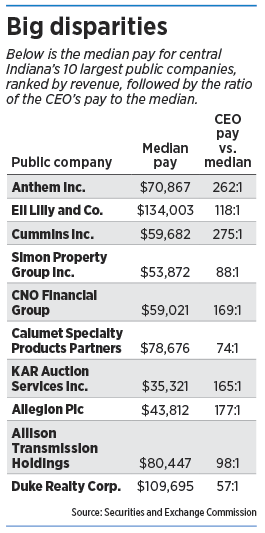Subscriber Benefit
As a subscriber you can listen to articles at work, in the car, or while you work out. Subscribe Now The numbers are interesting, but what do they mean?
The numbers are interesting, but what do they mean?
That’s the question raging in corporate America in the wake of a mandate that kicked in this year requiring public companies to disclose median employee pay and how it compares with the CEO’s compensation.
The numbers certainly provide plenty of fodder for critics who believe the gulf between rank-and-file pay and compensation for top brass has grown absurdly large. The Indiana company with the biggest gap was Patrick Industries, the Elkhart-based maker of RV components, where the median pay was $35,741. Meanwhile, CEO Todd Cleveland earned $11.9 million, 332 times the median for his 6,700-employee company.
On the other end of the spectrum was West Lafayette-based biotech firm Endocyte Inc., which is developing an experimental cancer drug. Median pay was a robust $233,042, and CEO Mike Sherman’s $1.8 million in compensation produced a pay ratio of 8:1.
The company’s employee mix helps explain the big rank-and-file paychecks. Endocyte has just 44 employees, 33 of whom work in R&D.
The median-pay disclosure was mandated by the 2010 Dodd-Frank Act following the financial crisis, but with an eight-year delay in implementation. The provision, passed during a wave of corporate scandals, was intended to help shareholders better understand and challenge executive-compensation practices.
Pay consultants see dubious value in the disclosures—in large part because firms calculate the median in different ways and have vast differences in how they’re structured. The consultants argue those variations make even comparisons between companies in the same industry of little value.
“If the intent was to cast judgment among firms that pay employees less in similar sectors, the Dodd-Frank rule has … failed on that front,” Deb Lifshey, managing director for the pay consultant Pearl Meyer, wrote on the company’s blog.

In some cases, two similar firms had wide differences in median pay, which left a false impression that one had far more generous compensation than the other. “Breaking down the analysis, however, revealed that it was not an apples-to-oranges comparison despite the similarity of companies, due to a variety of factors including where the company’s employees are located, the concentration of white collar vs. blue collar jobs, and level of outsourcing.”
Banking titans Bank of America and Citigroup provide a textbook example. Median pay at Bank of America was $87,115 vs. $48,249 for Citigroup. The difference merely reflects that two-thirds of Citigroup’s workers are overseas, many in lower-wage countries, while Bank of America is focused mainly on the United States, according to an analysis by the Progressive Policy Institute.
Despite the limitations of the disclosures, the public spotlight might up the pressure on corporate boards to rein in pay for top brass, especially if multiple years of reporting document the gulf between median pay and CEO pay is widening, those who believe executive compensation has gotten out of hand say.
One of those critics, Charles Elson, director of the Center for Corporate Governance at the University of Delaware, said one reason for the disparity is that rank-and-file employees’ pay is set internally, while CEO pay is set by comparing it to that of CEOs at peer companies.
“There is a leapfrog effect,” he said. “I got a raise because you got a raise. Then you got a raise because I got a raise.”•
Please enable JavaScript to view this content.
